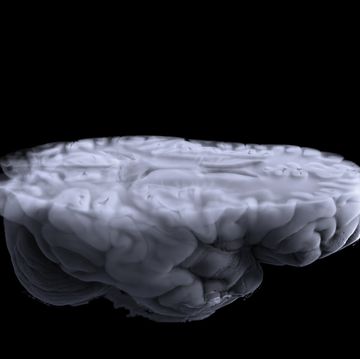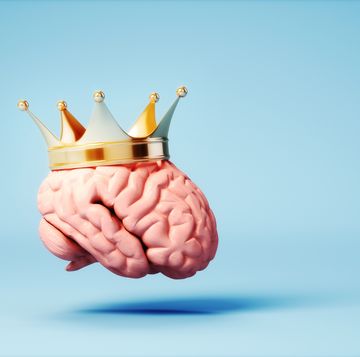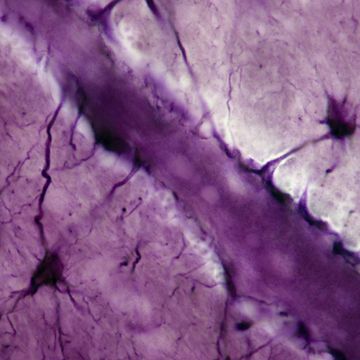To watch the entire human brain at work—seeing it as an interconnected whole rather than a group of connected regions—is a scientist's dream. Even the Obama administration thinks so. The White House is backing an initiative to create a brain-activity map, a record for the entire human brain that shows not only how the neurons are wired together but also which neurons are active at any moment. Think of it as a Google map that shows both networks of roads and the cars on those roads. The project, if funded by Congress, would cost about $3 billion over 10 years and would help researchers understand processes that are key to human health and that depend on interactions between far-flung neurons in the brain.
Researchers have taken the first stroke toward their goal: For the first time, they have created a brain-activity map for a vertebrate, albeit a tiny one: the larva of a zebrafish, with a minuscule brain many times smaller than a speck of water. The results appear today in Nature Methods. The experiments use optogenetics, a technique in which engineered neurons fluoresce when they are active, allowing researchers to record the series of bright colors that mark brain activity.
To create their map, Misha Ahrens and Philipp Keller from the Howard Hughes Medical Institute's Janelia Farm Research Campus in Virginia immobilized a live zebrafish larva between a light source on one side and a fluorescence-detecting camera on the other. They shone thin sheets of light on the zebrafish brain, illuminating it layer by layer. The camera took a picture of each slice, capturing the active neurons in that slice at that time. To see the entire brain at once at single-neuron resolution took 1.3 seconds and 41 total images; the researchers recorded this data continuously for about an hour, stitching the images together to create videos of the zebrafish brain in action. Ahrens and Keller estimate that they observed about 92 percent of the neurons in the zebrafish brain.
It's an impressive achievement, but how near are scientists to watching traffic in the human brain? Could this method scale up from the brain of the zebrafish larva, with its 100,000 neurons, to the human brain, with about a million times more?
What This Can Tell You About the Human Brain
Rafael Yuste, a neuroscientist from Columbia University, is the coauthor of a study on brain activity maps published last week in Science. This zebrafish work tells scientists that mapping brain activity for a vertebrate is possible. "It's a very good start for the brain activity map." John Donoghue, a neuroscientist from Brown University and an author on the same Science paper, is also pleased with the result: "This method is allowing us to view the collective activity of nearly an entire nervous system."
One of the goals for brain-activity maps is to identify neuronal traffic routes, or circuits, and figure out what they do. This paper identifies two different groups of neurons in the zebrafish brain that appear to fire in a coordinated way, and that Ahrens and Keller think represent circuits. For example, they observed that neurons of the hindbrain and the spinal cord seemed to fire together, and the researchers hypothesize that the circuit might be involved in swimming.
Watching the zebrafish brain can help scientists learn about structures it has in common with the human brain. "The zebrafish has a great deal of homology with the human brain, many of the same structures that show up in any vertebrate brain," says Mark Cohen, a neuroscientist from UCLA, "and there's clearly going to be an overlap in findings they share." Both humans and zebrafish have a cerebellum, which in humans looks like a ball of yarn located at the back of the brain and is important for coordinating movement. Studying how the cerebellum helps the zebrafish swim might give scientists ideas about how humans walk.
What It Can't Tell You
At the nitpicky level, this isn't quite an ideal brain-activity map—it is observing all the neurons over the course of 1.3 seconds, not all at once. That means some measurements within the same scan through the brain are more than a second apart. Scanning the brain at this rate, which is slow compared to how fast neurons can fire (300 times per second), also means the researchers may not catch every spike. Ahrens aspires to more precise data: "Ideally we want to report every single spike in every single neuron at exactly the time the spike happens. We're not imaging fast enough yet to be able to do that."
Worse, scientists say that they can't scale up this exact technique to look at mouse or human brains. The experiment was tailored to the zebrafish brain, which is thin and transparent, allowing light to penetrate it. "You wouldn't be able to do the same experiment [in a mouse] because the brain is too big and because the mouse has a skull which is not transparent," Ahrens says. Plus, these experiments relied on genetically engineered animals. Luckily, scientists have many other strategies in mind, such as using silicon nanoprobes to record neuron activity or even recording it in DNA by tracking the mistakes made by a DNA-copying enzyme. (It makes more mistakes in the presence of the positive ions that flood neurons when they fire.)
Lastly, the similarities between zebrafish and humans go only so far. The zebrafish brain lacks a neocortex, which, in the human brain, is involved in speech, thought, and other processes dear to us. "The main caveat is that zebrafish and humans are different in the most interesting possible ways," UCLA's Cohen says. "It's just always the classic problem of using model organisms to study humans."
Brain activity maps will likely be confined to model organisms like the zebrafish for quite a while. "I think it will be at least 10 years before it will be feasible to move this work into brains larger than a mouse's," says Gerry Rubin, vice president of the Howard Hughes Medical Institute and executive director of the HHMI Janelia Farm Research Campus. "And even there it will probably be only possible to do a portion of the brain at a time."
"The hope is we can discover basic principles about how brains process information in small brains," Rubin says. "There is every reason to expect that these mechanisms will be conserved in humans."













